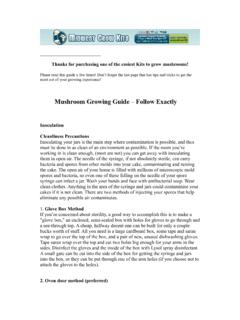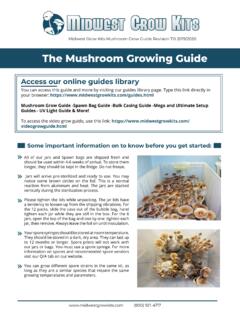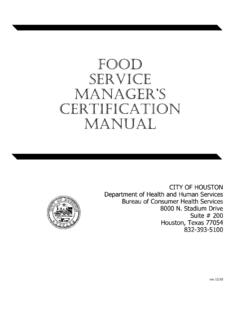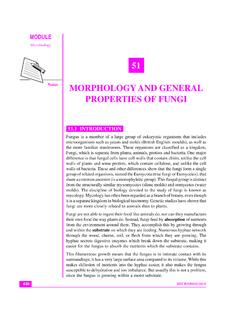Transcription of Microorganisms Important in Food Microbiology
1 FOOD QUALITY AND STANDARDS Vol. III - Microorganisms Important in Food Microbiology - Radomir Lasztity MICRO-ORGANISMS Important IN FOOD Microbiology . Radomir Lasztity Department of Biochemistry and Food Technology, Budapest University of Technology and Economics, Budapest, Hungary. Keywords: aerobic, anaerobic, bacteria, citric acid production by fungi, classification of molds(bacteria, yeasts), facultative aerobic, growth and multiplication(of molds, yeasts, bacteria), industrial use of micro-organisms (molds, yeasts, bacteria), mesophilic, microaerobic, molds, morphological characteristics (of molds, yeasts, bacteria), physiological characteristics (of molds, yeasts, bacteria), psychrophilic, spore , thermophilic, yeasts, yeasts of industrial importance. Contents S. TE S.
2 1. Introduction R. AP LS. 2. Molds Morphological Characteristics Physiological Characteristics C EO. Classification of Molds and Molds of Industrial Importance. Citric Acid Production by Fungi 3. Yeasts General Yeasts of Industrial Importance E . 4. Bacteria H. General PL O. Morphological Characteristics Growth and Multiplication M SC. Classification of Bacteria Important in Food Microbiology . Industrial Use of Bacteria. Lactic Acid Bacteria SA NE. Production of Enzymes Production of Vinegar Glossary U. Bibliography Biographical Sketch Summary In addition to natural microflora determined by type of plant or animal and environmental conditions, every food may be contaminated from outside sources on the way from the field to the processing plant, or during storage, transport and distribution.
3 There are thousands of different types of micro-organisms everywhere in air, soil and water, and consequently on foods, and in the digestive tract of animals and human. Fortunately, the majority of micro-organisms perform useful functions in the environment and also in some branches of of food industry, such as production of wine, beer, bakery products, dairy products etc. On the other hand unwanted spoilage of foods Encyclopedia of Life Support Systems (EOLSS). FOOD QUALITY AND STANDARDS Vol. III - Microorganisms Important in Food Microbiology - Radomir Lasztity is generally caused by micro-organisms and contamination of food with pathogens causes food safety problems. The micro-organisms occurring on and/or in foods are from a practical point of view divided into three groups: molds, yeast and bacteria.
4 Molds are generally concerned in the spoilage of foods; their use in the food industry is limited ( mold ripened cheese). Yeasts are the most widely used micro-organisms in the food industry due to their ability to ferment sugars to ethanol and carbon-dioxide. Some types of yeast, such as baker's yeasts are grown industrially, and some may be used as protein sources, mainly in animal feed. Bacteria Important in food micribiology may be divided into groups according to the product of fermentation, lactic acid bacteria, acetic acid bacteria, propionic acid Bearing in mind the food constituent attacked (used as food for micro- organisms), proteolytic, saccharolytic and lipolytic bacteria may be distinguished. S. TE S. R. AP LS. Their systematic classification is based primarily on morphological and physiological properties ( aerobic and anaerobic bacteria, gas forming bacteria, etc.)
5 Lactic acid bacteria are widely used in the dairy industry, and acetic acid bacteria in vinegar C EO. production. Many bacteria are known as micro-organisms that cause spoilage and some are pathogens ( , staphylococci, etc.). 1. Introduction E . Both foods of plant and animal origin normally carry a microflora on the surface of their H. parts. Animals also have an intestinal microflora. Both animals and plants may also PL O. become contaminated from outside sources. The inner, healthy tissues of plants and animals, however, have been reported to contain few living micro-organisms, or none. M SC. The fruit or vegetable is harvested, milk is drawn, fish and other products are obtained from natural waters, and animals are collected and slaughtered all carrying their usual SA NE.
6 Microflora. After initial handling, further contamination begins and it continues while the product is being processed and prepared. U. Foods may be contaminated by each other and by pieces of equipment with which they come in contact. Air, dust, water, and ingredients may add their quota of contaminants. Whenever food is handled personally by human beings, there is always the possibility of addition of human pathogens. (Sources of microbial contamination of foods are treated in detail in Spoilage and Preservation of Food). In the framework of this article a brief overview will be given about micro-organisms that play an Important role in production, storage and consumption of foods. Their occurrence, characteristics used for identification, conditions of growth and eventual industrial use will be treated (foodborne pathogens will be discussed in a separate chapter Foodborne Diseases).
7 Micro-organisms will be discussed in three arbitrary groups, normally used by food microbiologists: molds, yeasts and bacteria. Encyclopedia of Life Support Systems (EOLSS). FOOD QUALITY AND STANDARDS Vol. III - Microorganisms Important in Food Microbiology - Radomir Lasztity 2. Molds The term mold is applied to certain multicellular, filamentous fungi whose growth on foods is usually readily recognized by its fuzzy or cottony appearance. Generally molds are concerned in the spoilage of foods; moldy or mildewed food is considered unfit to eat. On the other hand some of molds are used in manufacture of different foods and are ingredients of some foods. Some kinds of cheese are mold -ripened ( Roquefort, Camembert). Molds are grown as feed and food and are employed to produce products used in foods, such as amylases and other enzymes for bread making or citric acid used in soft drinks.
8 Molds are major contributors in the ripening of many oriental foods. A. species of Bothrytis cinerea, is responsible for the noble rot of grape. Molds are used for production of several antibiotics. Morphological Characteristics S. TE S. The gross appearance of a mold growing on a food is often enough to indicate its genus. R. AP LS. Some molds are fluffy, others are compact. Some look velvety on the upper surface, some dry and powdery, and others wet or gelatinous. Pigments in the mycelium red, purple, gray, black, etc. are also characteristic. Some molds are restricted in size, but C EO. others seem limited only by the food or container. Macroscopically the mold consists of a mass of branching, interwined filaments called hyphae (singular hypha), and the whole mass of these hyphae is known as a mycelium.
9 Hyphae may be classed as vegetative or fertile based on their biological function. The E . vegetative hyphae or growing hyphae are concerned with the nutrition of the mold and H. the fertile ones with the production of reproductive parts. The hyphae of some molds are PL O. full and smooth, but the hyphae of others are characteristically thin and ragged. A few kinds of molds produce sclerotia (singular sclerotium) which are tightly packed masses M SC. of hyphae, often thick-walled, within the mycelium. These sclerotia are considerably more resistant to heat and other adverse conditions than the rest of the mycelium and for this reason may be Important in some processed food products. SA NE. With microscopic study, further details of molds may be recognized. In the group of molds called septate the hyphae are divided by cross-walls into cells.
10 The hyphae of the U. nonseptate group consist apparently of cylinders without cross walls. The reproductive parts or structures of molds are the spores, which are mainly asexual. Such spores are produced in large numbers and are readily spread by air. Spores that settle on favorable substrates can initiate a new phase of growth and develop into a new mycelium. Physiological Characteristics In general, molds require less moisture than bacteria and yeasts. Molds differ considerably among themselves as to optimum water activity and range of water activity for germination of spores. The minimum water activity for spore germination has been found to be as low as for some molds and as high as for others. Each mold has an optimum of water activity and a range of water activity for growth.















